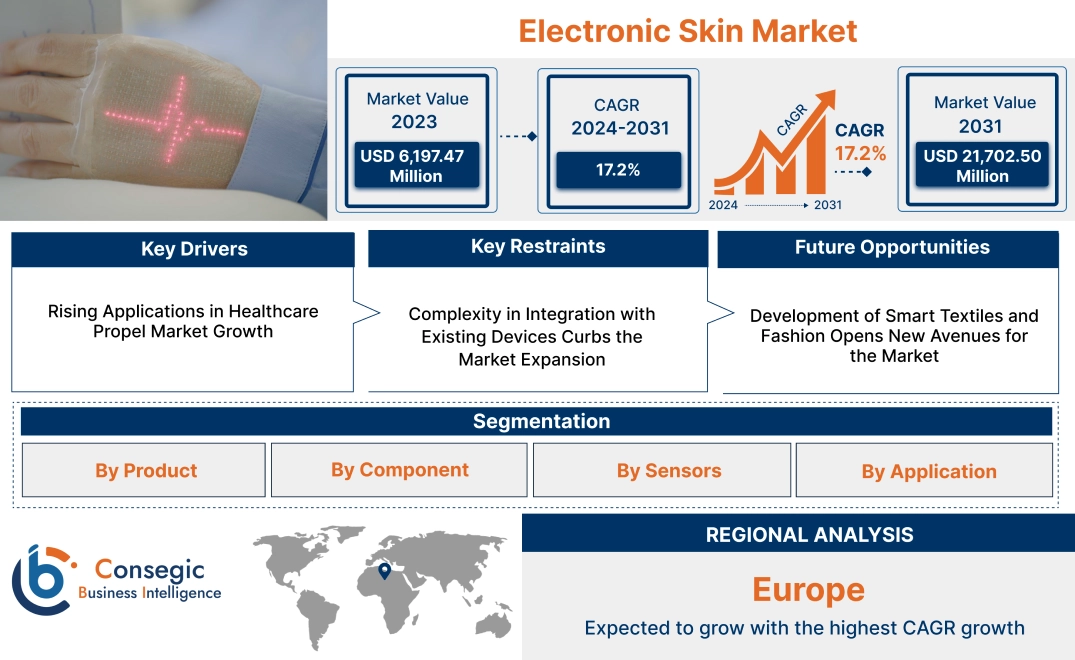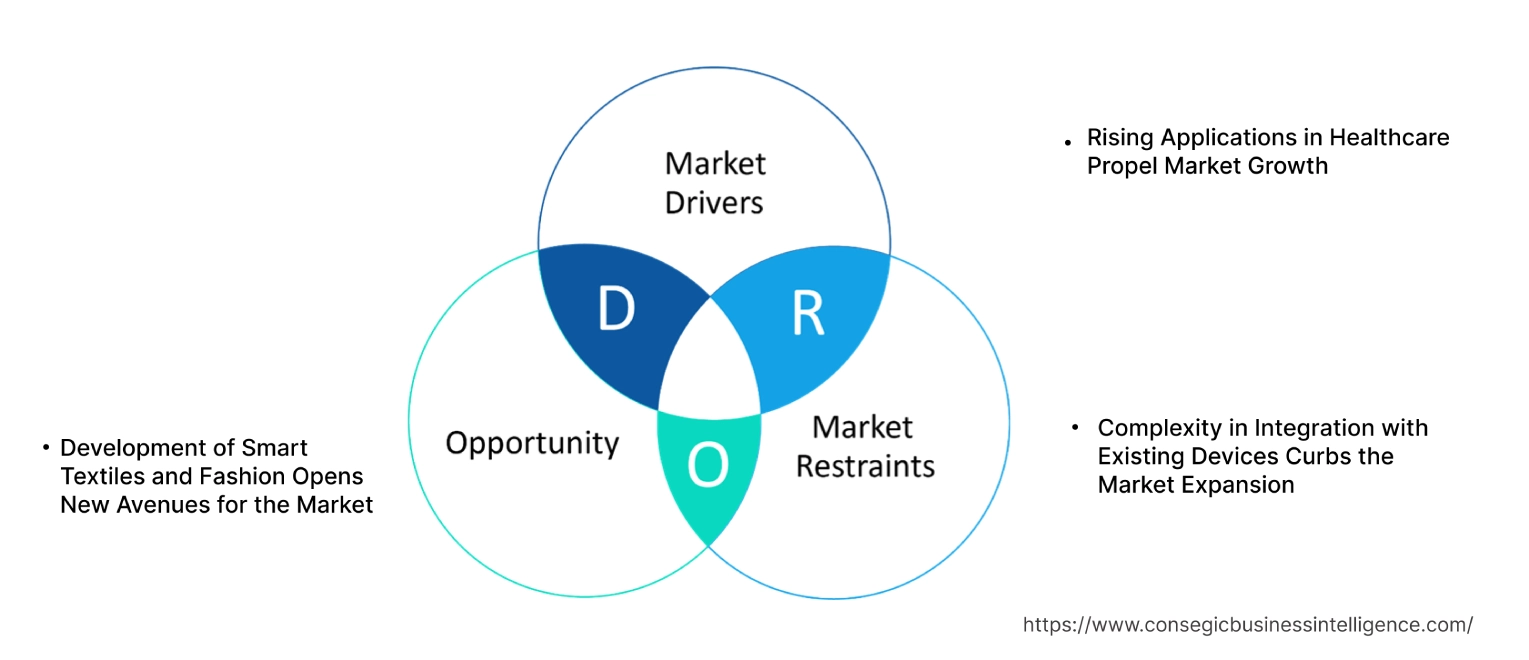Electronic Skin Market Size:
Electronic Skin Market size is estimated to reach over USD 21,702.50 Million by 2031 from a value of USD 6,197.47 Million in 2023, growing at a CAGR of 17.2% from 2024 to 2031.
Electronic Skin Market Scope & Overview:
Electronic skin is a flexible, stretchy wearable synthetic material that is engineered to mimic the properties and functionalities of natural human skin. It integrates various sensors to detect stimuli like temperature, pressure, humidity, and motion. It enables its users to perceive environmental factors and react accordingly. E-skin consists of materials such as silicone rubber, polyimide, and other elastomers which form its base, also known as substrate, and offer mechanical stability and flexibility. E-skin also employs integrated flexible circuits made from conductive materials like graphene or carbon nanotubes for signal transmission and processing. Some e-skin designs incorporate sources like thin-film batteries or energy-harvesting elements like solar cells. They are biocompatible, making them safe to stick to the skin for prolonged periods. Their key properties include self-healing of minor damage for enhanced durability and high sensitivity for quick reactions to changes in stimulus. The benefits of e-skin include the provision of constant monitoring without invasive medical devices. They are also energy-efficient and comfortable and can improve the functionality of prosthetic limbs and robots. The concept of e-skin is revamping fields of health care, human-computer interaction, and robotics.
How is AI Impacting the Electronic Skin Market?
AI is significantly impacting the electronic skin market by enabling advanced data analysis, predictive healthcare, and personalized experiences. Also, AI algorithms have the ability to process complex sensor data from electronic skin in real-time, leading to more accurate health diagnostics and sophisticated human-machine interactions. Moreover, AI enhances electronic skin functionality by improving sensor performance, enabling self-healing properties, and optimizing material discovery. Thus, the integration of AI and electronic skin is driving advancements in prosthetics, robotics, and personalized health monitoring.
Electronic Skin Market Dynamics - (DRO) :
Key Drivers:
Rising Applications in Healthcare Propel Market Growth
Electronic skin sensors monitor important signs such as heart rate, blood pressure, and body temperature repeatedly and non-invasively, providing real-time data to healthcare professionals. These sensors are also suitable for early detection of health strains like respiratory issues or irregular heartbeats, making them useful for remote patient care of chronic diseases. When E-skin is integrated into prosthetic limbs it improves the functionality of artificial limbs by giving the patients a sense of touch. They can also be incorporated into devices to monitor and adjust rehabilitation therapy for patients recovering from major injuries or surgeries. E-skin is often crafted to help in wound healing processes where sensors monitor the healing parameters like moisture and pH levels of the wound. It also facilitates skin regeneration and can seamlessly mimic natural skin properties for patients with severe skin damage.
- In 2023, STMicroelectronics and DuPont Liveo Healthcare are developing e-skin patches to monitor cardiac rate in patients. This new wearable product could self-sense cardiac events before its insurgence by interpreting biosignals and monitoring electrical and mechanical heart rates.
Thus, as e-skin technologies like AI and data integration transform the way patients are monitored, diagnosed, and treated, electronic skin market expansion is imminent.
Key Restraints :
Complexity in Integration with Existing Devices Curbs the Market Expansion
E-skin technology needs seamless communication with current medical equipment and healthcare IT systems, though the current devices lack basic cohesive compatibility. Data standardization through electronic health records (EHR) systems varies from one system to another which makes e-skin integration difficult and leaves the provision of inaccurate or incomplete data transmission. Combining e-skin tech with wearable devices is technically challenging because each device has its protocols for sensor calibration and power requirements. They also require ultra-low power to stay operational for longer periods and continuous data connectivity which creates a technical barrier for current IT systems employed in the medical field. There is a significant cost associated with the modifying or upgrading of current systems to integrate e-skin technology which also curbs its adoption by major hospital and healthcare facilities.
- An article published in 2022 on the ASC Publications highlights how the implementation of e-skin in routine healthcare to other aspects faces monumental barriers such as incompatible material selection and unbalanced systems. There are stringent standards like the inconsistency of multisensor integration for large-scale commercialization of e-skin-based products.
Therefore, as per market trends analysis, the electronic skin market growth is stunted by the complex user experience of incorporating e-skin with current regulatory standards.
Future Opportunities :
Development of Smart Textiles and Fashion Opens New Avenues for the Market
Smart textiles embedded with e-skin sensors monitor vitals continuously like stress levels, heart rate, etc. This is beneficial for athletes, patients, or simply health-conscious consumers who want to keep their vitals in check. E-skin is also integrated into fabrics for more natural wearable designs, unlike conventional health monitors. In fashion, sportswear, and designer clothes are being integrated with e-skin tech to track performance metrics and be responsive to external stimuli. Smart textiles detect everyday health indicators from posture correction to monitoring sleep patterns. It also offers optimal comfort to the wearer as it can automatically adjust its temperature in response to body heat, making it a practical choice for everyday use. They are also flexible, stretchable, and even have washable components which add to their suitability as daily wear. E-skins are made from biodegradable and durable elements, adding to their long-term sustainability, and making them a cost-effective choice.
- An article published in the online journal ‘Nature' in April 2024 discusses a hydrogel-based e-skin smart wearable capable of independent sensing of temperature and body strain. It monitors foot movements and head-down state which makes them suitable for correcting neck posture, especially for people in sedentary jobs.
Therefore, smart textiles and the fashion industry are incorporating an immersive user experience, boosting the electronic skin market opportunities.
Electronic Skin Market Segmental Analysis :
By Product:
The market is bifurcated, based on product, into Electronic Patches and Electronic Skin Suits.
Trends in the Product:
- The recent adoption of photovoltaic systems in skin patches is enhancing their effectiveness in patient monitoring.
- Recently, by utilizing iontophoresis, targeted and controlled drug delivery can be made through e-skin devices.
Electronic Patches accounted for the largest revenue share in the electronic skin market share in 2023.
- Electronic patches help in monitoring bodily parameters such as heart rate, oxygen saturation, blood pressure, etc., for chronic disease management, drug delivery, and recovery.
- They offer patients with reliable real-time and non-invasive monitoring for patients suffering from respiratory disorders, diabetes, etc.
- They aid in continuous health monitoring which helps in the collection of valuable biometrics for preventive care and early diagnosis.
- Advancements in material science have led to the development of battery-free electronic patches or bioelectrical-powered patches that have more efficiency in data analysis.
- For instance, in 2023 researchers from the Terasaki Institute for Biomedical Innovation (TIBI) announced the development of e-skin patches that offer regular, simultaneous monitoring of various body signs. This new electronic patch leverages a gelatine-based highly porous substrate to provide enhanced biocompatibility, self-adhesion, and biodegradation. In-depth permeability and better breathability are also offered by the gelatine-based electronic patch.
- Thus, as regulatory approvals for electronic patches gain traction for their credibility and widespread usage, this segment contributes to the largest revenue generation, driving the electronic skin market demand.
Electronic Skin Suits are expected to have the fastest CAGR during the forecasted period.
- Electronic skin suits offer sophisticated and comprehensive body monitoring that is far beyond the provisions of typical wearables such as smartwatches. They can perform a full-body physiological check including measuring the hydration and oxygen levels of the user.
- They offer transformative remote patient monitoring which helps in better patient satisfaction through faster recovery and personalized treatments.
- They provide real-time sensory feedback which enables soft robots or exoskeletons to move in coordination with human movements.
- These suits can detect and identify early signs of medical conditions which leads to early preventive treatment for patients with musculoskeletal problems, cardiac issues, etc.
- For instance, in 2021, Xenoma Inc., a Japanese smart textile firm, launched an electronic skin (e-skin) suit, EMStyle Professional. This comfortable and efficient electrical muscle stimulation suit allows fitness experts to transmit personalized stimulation signals to the wearer's body through 24 electrodes. It enhances the effectiveness of their workout session and can give the benefits of a 20-minute workout with just a few light exercises.
- Therefore, as per analysis, electronic skin suits are beneficial for increasing operational accuracy and functionality of personalized care, boosting the electronic skin market trends.
By Component:
The market is segmented based on components into Sensors, Stretchable Circuits, Photovoltaic Systems, Stretchable Conductors, and Electroactive Polymers.
Trends in the Component:
- Recently, graphene and carbon nanotubes have been integrated into electroactive polymers-based e-skin to make them more stretchable and flexible.
- There is a current trend of integrating thin and flexible solar cells into e-skin to provide continuous power.
Sensors accounted for the largest revenue share in the electronic skin market share in 2023.
- Sensors allow e-skin to replicate the sensory capabilities of human skin like detection of pressure, temperature, humidity, and other stimulus.
- They are leveraged in the medical sector for health monitoring systems, prosthetics, rehabilitation, etc. as they can easily monitor vitals.
- Sensors offer human-machine interaction, allowing them to perform delicate tasks with precision.
- They are utilized in wearables where they can detect movement, track fitness metrics, and monitor heartbeat repeatedly.
- Advancements in sensor technologies such as enhanced biocompatibility have made e-skin devices effective, versatile, and safe.
- Thus, as e-skin sensors integrate components like the Internet of Things (IoT) real-time data collecting contributes to the electronic skin market demand.
Stretchable Circuits are expected to have the fastest CAGR in the electronic skin market during the forecasted period.
- Stretchable circuits are designed to maintain their functionality while being sent, stretched, compressed, etc., making them suitable for e-skin applications like prosthetics or healthcare devices. It conforms to the body's natural movements without impeding high-end performance.
- Stretchable circuits in wearable devices offer heavy flexibility and comfort to the user. It also improves its capability of continuous data tracking even during physical activities.
- They are valuable in wound healing and rehabilitation devices as their ability to stretch and move with the body makes them suitable for long-term and noninvasive vitals monitoring.
- In soft robotics, the ability of circuits to stretch and bend without letting the robots perform complex tasks naturally, mimicking human flexibility.
- Stretchable circuits in smart textiles help in checking the user's physiological parameters, activity levels, environmental conditions, etc.
- Therefore, as per electronic skin market analysis, stretchable circuits develop lightweight and flexible e-skin devices that offer comfort and enhanced performance to their users, resulting in market growth.
By Sensors:
The market is segmented based on sensors into Tactile Sensors, electro-physiological Sensors, Chemical Sectors, and others.
Trends in the Sensors:
- Recently, self-powered chemical sensors that employ energy-harvesting technologies have risen in popularity.
- The integration of AI has led tactile sensors to offer more immersive virtual reality (VR) and augmented reality (AR).
Tactile Sensors accounted for the largest revenue share in 2023.
- Tactile sensors are critical in enhancing the sensitivity and responsiveness of electronic skin by mimicking the human sense of touch. It allows robotics and prosthetics to become more advanced.
- Consumer electronics like touch-sensitive wearables, smartphones, gaming devices, etc., are integrated with tactile sensors that help them provide haptic feedback and improve user experience.
- Tactile sensors that are integrated with AI and machine learning can interpret touch data in real-time, improving the overall functionality of e-skin devices.
- For instance, an article published in the National Library of Medicine (NLM) talks about the way researchers at Tsinghua University developed a new dual-modal tactile e-skin sensor. It improves the sensing properties of robots as well as lets them analyze data by leveraging a human's sense of touch.
- Thus, as governments invest in developing e-skin technologies, tactile sensor technology boosts the electronic skin market expansion.
Electrophysiological Sensors are expected to have the fastest CAGR during the forecasted period.
- Electrophysiological sensors monitor electrical activity in biological systems like heart (ECG), muscle (EMG), and brain (EED) activities. They offer precise data making them crucial in clinical and consumer health monitoring.
- The global rise in cardiovascular diseases, neurological disorders, epilepsy, etc. has necessitated the demand for non-invasive continuous monitoring. Electrophysiological sensors can continuously track and record electrical signals helping in early diagnosis and management of these diseases.
- The advancements such as sensor miniaturization, sensitivity, flexibility, etc. have resulted in more sophisticated electrophysiological sensors that offer greater accuracy.
- As healthcare moves towards personalized medicine, electrophysiological sensors offer detailed records of particular patients' physiological conditions. This helps in the formulation of patient-centric plans and optimizes patient care.
- For instance, an article published by the National Library of Medicine (NLH) highlights the use of a 10mm thick polyurethane nanomesh that is bolstered with a gas-permeable hydrogel sensor. It can self-attach itself onto human skin for prolonged periods for repeated and high-end electrophysiological monitoring.
- Therefore, increased awareness of health and wellness expands the e-skin market, making this segment's faster growth possible in the future.
By Application:
The market is segmented based on application into Drug Delivery Systems, Health Monitoring Systems, Cosmetics, and Wearable Technology.
Trends in the Application:
- Recently, smart face masks in cosmetics and skincare which incorporate e-skin sensors into sheet masks are on the rise. It can track skin conditions and optimize the delivery of active ingredients to that area.
- E-skin-based health monitoring systems are recently being equipped to detect metabolic and physical stress through an analysis of biomarkers like sodium in the sweat of patients.
Health Monitoring Systems accounted for the largest revenue share of 38.24% in 2023.
- E-skin tech is effective in continuous monitoring of health and providing real-time tracking of vital signs like respiratory rates, glucose levels, etc. This capability is increasingly important for managing chronic illnesses.
- E-skin tech in health monitoring systems plays a significant role in early detection and diagnosis of health issues by providing continuous physiological data.
- The aging demographic needs long-term health monitoring and e-skin-based health monitoring solutions can act as a second skin. It offers elderly patients a non-invasive analysis of critical health parameters.
- Health monitoring systems using e-skin tech are integrated with AI and data analytics tools, making them capable of getting more accurate patient insights.
- Thus, as per the electronic skin market analysis, advancements made in material science have made e-skin health monitoring systems more feasible in the medical field contributing to its large revenue generation.
Wearable Technology is expected to have the fastest CAGR during the forecasted period.
- Wearable e-skin techs track vitals like heart rate, offering users with real-time health monitoring which is beneficial for personal health management and preventive care.
- E-skin tech results in the advancement of flexible and stretchable electronics that can seamlessly conform to skin. This helps the wearable technology by making them comfortable and light without impeding their functionality.
- Wearables such as fitness trackers, smart clothing, and smartwatches are equipped with e-skin sensors that detect sleeping patterns, stress levels, etc.
- E-skin wearables are non-invasive and offer constant health monitoring, making them imperative in elderly care.
- Advanced connectivity such as the Internet of Things (IoT), 5G networks, etc., give wearable e-skin devices the provision to communicate seamlessly. This allows for better data gathering and analysis, driving their utility in personal and clinical settings.
- Therefore, consumers prefer wearable technology for personalized haptic feedback, driving the electronic skin market trends.
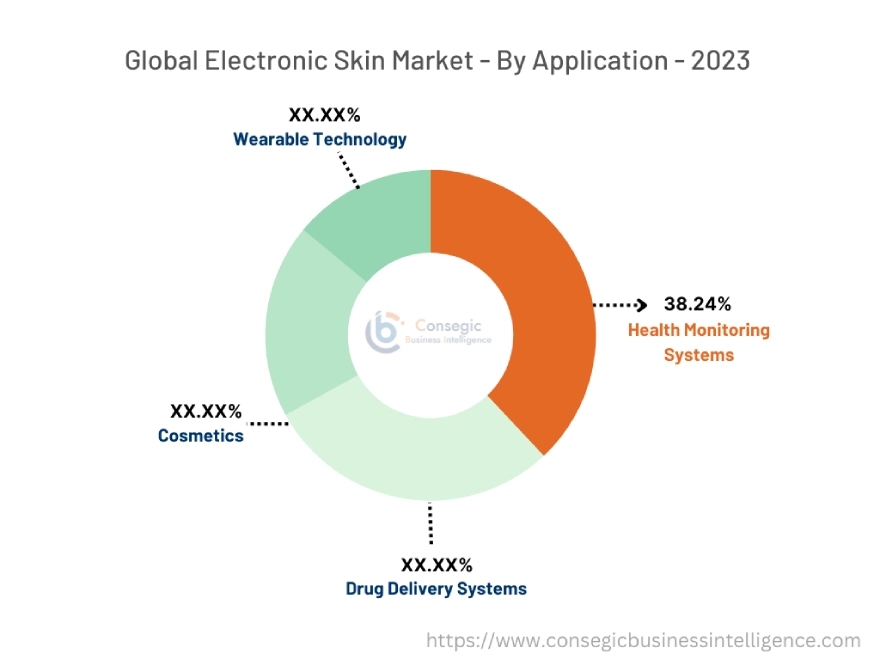
Regional Analysis:
The regions covered are North America, Europe, Asia Pacific, the Middle East and Africa, and Latin America.
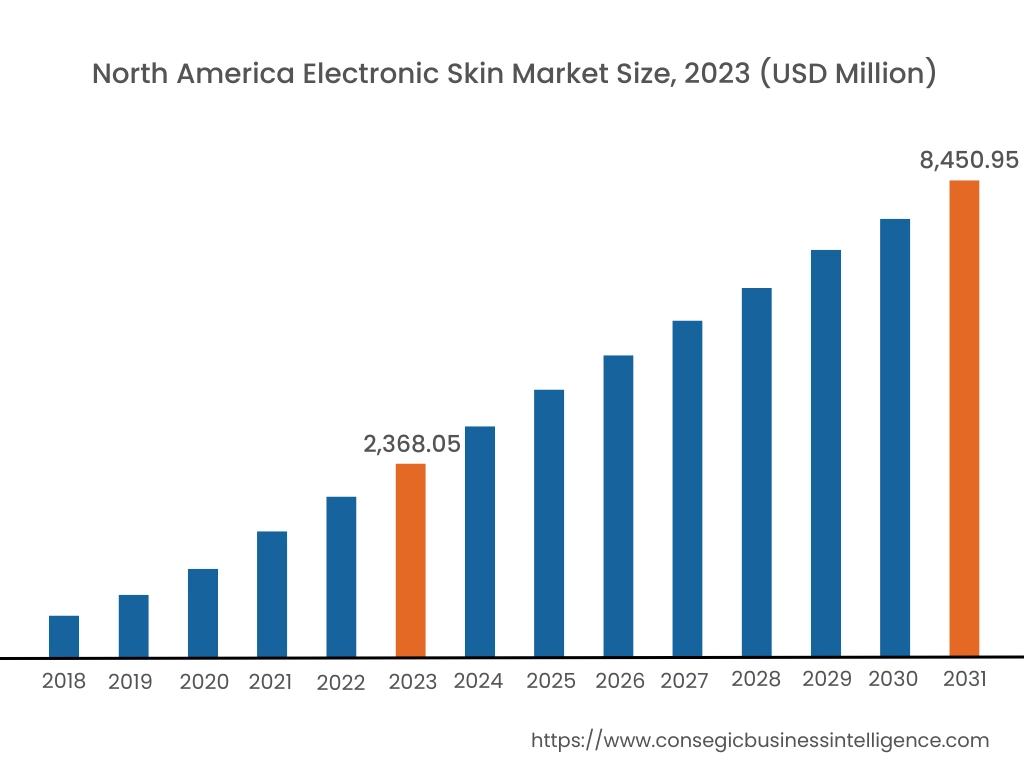
In 2023, North America accounted for the highest market share at 38.21% and was valued at USD 2,368.05 Million, and is expected to reach USD 8,450.95 Million in 2031. In North America, the U.S. accounted for the highest market share of 75.56% during the base year of 2023. North America, especially in the US, has an advanced infrastructure for supporting electronic skin technology. The region can adopt e-skin and integrate it into the fields of healthcare where it can monitor health, and help in rehabilitation and prosthetics. There is also a strong ecosystem of research and development (R&D) where universities, research institutions, tech firms, etc lead significant innovations for the development and integration of e-skin. The government also funds and supports the R&D drive contributing to the electronic skin market growth.
- In January 2024, Texas A&M University College of Engineering (USA) published an article on the way 3D e-skin is a promising innovation in healthcare and medicine as well as human-machine synergy. A group of researchers from Texas A&M University leveraged nanoengineered hydrogels that mimic thermal and tunable electronic components for biosensing in innovating e-skin. It has the to duplicate the actions of human skin like stretching, flexing, and sensing.
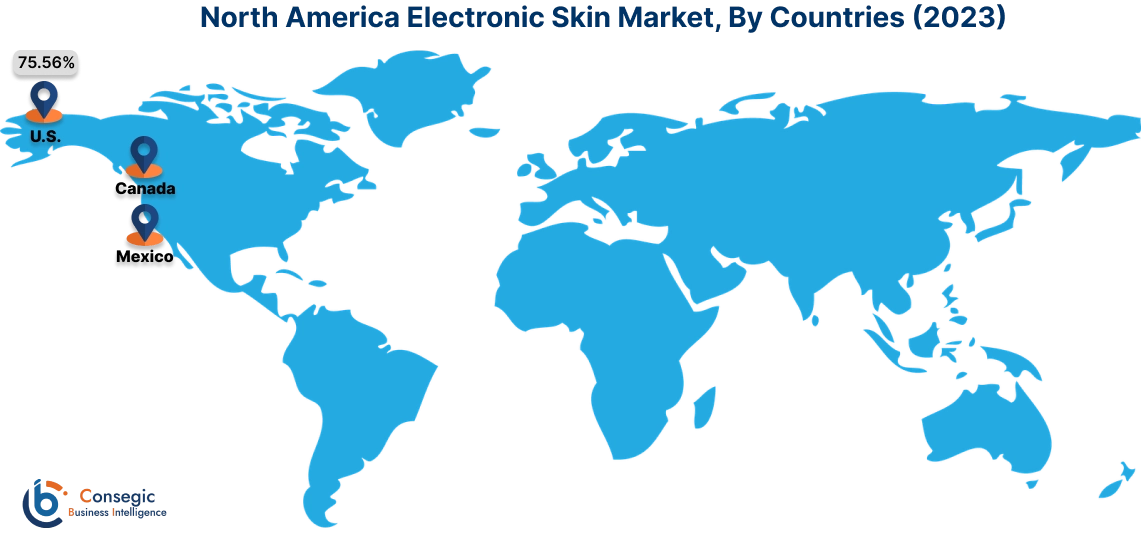
Asia Pacific (APAC), particularly China, Japan, South Korea, etc. is home to some of the largest global electronics manufacturers who are known for their expertise in semiconductors, circuits, flexible electronics, etc. These are important components of wearable smart textiles leading to an expansion of the e-skin market in this region.
- The Japan News published an article in 2023, which talks about a group of researchers from the University of Tokyo who outlined the development of a full-body e-skin that would be set with electronic circuits. This smart textile would help in measuring information like muscle movement, posture, heartbeat, etc. The data would be studied by leveraging AI to pre-detect symptoms of illness.
Europe is expected to witness the fastest CAGR over the forecast period of 17.9% during 2024-2031. Europe has the largest concentration of elderly demographic on the global map, especially in the regions of Spain, Italy, Germany, etc. This aging population often requires wearable devices, like e-skin to monitor vitals for managing chronic health conditions.
The Middle East and Africa (MEA) is a hub of medical tourism, like Turkey or the UAE, which fosters an environment for high-end healthcare services that include advanced e-skin tech as a part of their premium medical care packages. Latin America, particularly regions like Mexico, Argentina, etc., has developed a class of people that are more aware and health-conscious than before. This drives the demand for advanced technologies like e-skin which could offer non-invasive and convenient solutions to healthcare.
Top Key Players & Market Share Insights:
The Electronic Skin Market is highly competitive with major players providing products and services to the national and international markets. Key players are adopting several strategies in research and development (R&D), product innovation, and end-user launches to hold a strong position in the electronic skin market. Key players in the global electronic skin industry include-
- Xenoma Inc. (Japan)
- e-Paper Innovation Ltd (Germany)
- Argotec LLC (USA)
- MC10, Inc. (USA)
- VivaLNK, Inc. (USA)
- iRhythm Technologies, Inc. (USA)
- Medidata (USA)
- Koninklijke Philips N.V. (Netherlands)
- Rotex Global, LLC (USA)
- Intelesense Technologies (USA)
- SMARTLIFEINC (UK)
Recent Industry Developments :
Product Launch:
- In May 2024, L'Oréal, a French beauty firm, announced the launching of six innovative tech inventions for the beauty industry at Viva Technology. Among these innovations is an e-skin tech that would seamlessly mimic human skin for scientific research and product testing. This new bio-printed skin can also imitate acne, tan, and wound healing of actual skin. They aim to pioneer cruelty-free product testing.
Product Enhancement:
- In June 2024, scientists from Tsinghua University (China) developed a 3D e-skin that duplicates human skin and can decipher and sense mechanical signals like friction, strain, etc. It has a proper replica of human skin i.e., an epidermis, dermis, and subcutaneous tissue. This new bionic 3D e-skin can precisely perceive outside stimuli and can revamp biological detection, human-computer interaction, biomedicine, etc.
Electronic Skin Market Report Insights :
| Report Attributes | Report Details |
| Study Timeline | 2018-2031 |
| Market Size in 2031 | USD 720.59 Million |
| CAGR (2024-2031) | 17.2% |
| By Product |
|
| By Component |
|
| By Sensors |
|
| By Application |
|
| By Region |
|
| Key Players |
|
| North America | U.S. Canada Mexico |
| Europe | U.K. Germany France Spain Italy Russia Benelux Rest of Europe |
| APAC | China South Korea Japan India Australia ASEAN Rest of Asia-Pacific |
| Middle East and Africa | GCC Turkey South Africa Rest of MEA |
| LATAM | Brazil Argentina Chile Rest of LATAM |
| Report Coverage |
|
Key Questions Answered in the Report
Who are the major players in the electronic skin market? +
The major players in the market include MC10, Inc. (USA), Xenoma Inc. (Japan), VivaLNK, Inc. (USA), iRhythm Technologies, Inc. (USA), Koninklijke Philips N.V. (Netherlands), e-Paper Innovation Ltd (Germany), Rotex Global, LLC (USA), Medidata (USA), Intelesense Technologies (USA), and SMARTLIFEINC (UK).
Which region will lead the electronic skin market? +
North America will lead the global electronic skin market in the future.
What specific segmentation Details are covered in the electronic skin market report? +
The electronic skin market is segmented into products, components, sensors, and applications.
Which is the fastest-growing region in the electronic skin market? +
Europe is the fastest-growing region in the electronic skin market.
